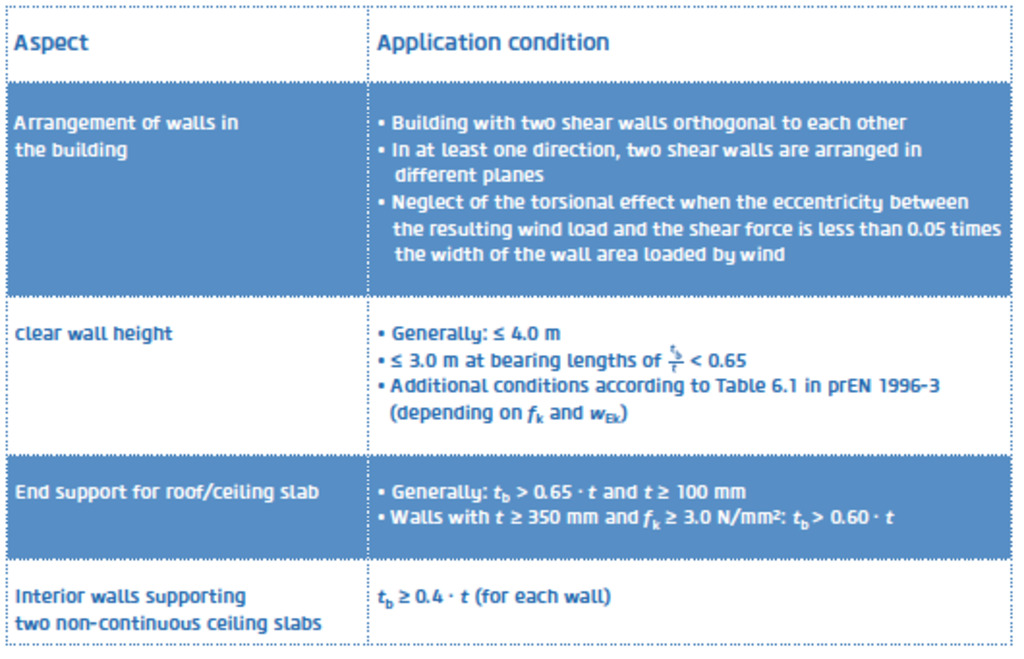Application & Construction
Differences in normative regulations
Effects of the new draft of EN 1996-3 on the design of AAC masonry walls
Loading... 
1. Description of the current situation
1.1 State of standardisation
Currently, the Eurocodes and thus also the Eurocode 6 for the design and construction of masonry structures are being revised. Final drafts for all four parts of the standard (FprEN 1996‑1-1, prEN 1996‑1-2, prEN 1996‑2 and FprEN 1996‑3) are now available. For the draft version of EN 1996‑3 considered here, the "Formal Enquiry", in which all experts are called upon to review and comment on the document, has taken place and the document has been confirmed for the next step of the standardization process, the "Formal Vote". According to the current status, this is to start in April 2023. If approved, the standard would be confirmed at European level. As part of the overall project, work will subsequently begin on the preparation of the national annexes, which will supplement the European standards.
The design of masonry walls in Central Europe is very often based on the simplified design methods according to EN 1996‑3 and the associated national annexes. Consequently, this standard is of great importance here.
1.2 Effects on the design of masonry walls
The analysis of the draft version of EN 1996-3 in the 2021 version revealed some significant deviations in the maximum load-bearing capacities of structures for various wall types. This is particularly true for masonry with compressive strengths of fk ≤ 2.0 N/mm² and is also influenced by the type of construction, especially by the type of support of the ceiling slab on the wall (full or partial support).
Especially for masonry made of building materials with a low modulus of elasticity, comparative calculations showed considerable reserves in the load-bearing capacity. This was also confirmed by an expert opinion on the load-bearing capacity of squat walls made of AAC masonry according to prEN 1996‑3:2021 by Prof. Dr.-Ing. Carl-Alexander Graubner (Convener of Project Team for CEN/TC 250/SC 6/WG 2). The expert opinion has been incorporated into the standardisation process and the contents are taken into account in the current draft (FprEN 1996‑3:2022).
2. Comparison of the draft standard prEN 1996-3:2021 with the currently valid version
The focus of the article is on the comparison of the load capacity verification according to the currently valid European version of EN 1996‑3 with the draft versions of EN 1996-3 from 2021 and 2022.
In addition to changes in the general part and the sections related to the application boundary conditions, in particular the design methodology for masonry walls subjected to vertical loads and wind loads was changed.
The basic approach with regard to determining the load-bearing capacity remained similar: The permissible compressive stress or the characteristic compressive strength of the masonry is reduced by a reduction factor and the load-bearing capacity of the wall derived accordingly. This reduction factor takes into account the relevant influencing factors such as wall dimensions (including the ratio between wall height and wall thickness), type and eccentricity of load application, as well as span of the supported ceiling slabs.
2.1 Conditions of application of the simplified calculation methods
The conditions for the application of the simplified calculation methods have also been adapted as part of the revision of EN 1996-3:2010-12. The main differences are summarized Table 1.
Table 1: Supplementary and adapted conditions for the application of prEN 1996‑3:2021 compared to the 2010-12 edition.

The rest of this article is exclusively available for subscribers.